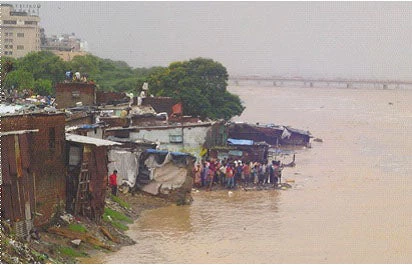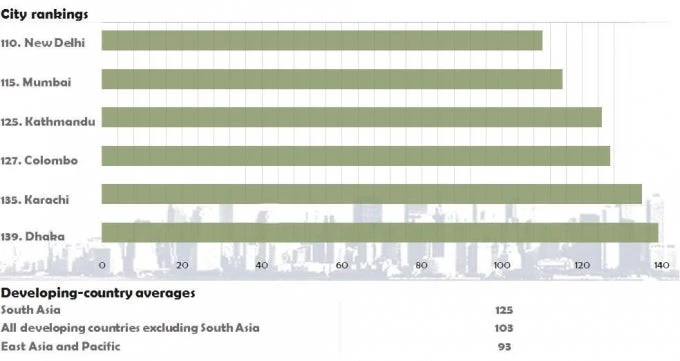

Robert Solow once said: “Livability is not a middle-class luxury, it is an economic imperative.” But how related are livability and economic development? Furthermore, how can we define and measure livability?
Recently as part of the South Asia Urbanization Flagship Report, Leveraging Urbanization in South Asia: Managing Spatial Transformation for Prosperity and Livability, our team compared a sample of South Asian cities with peers from around the world. The report’s framework considered livability (along with prosperity) as being a key outcome of urbanization.
We wanted to highlight that while urbanization has undoubtedly contributed to economic growth in South Asia, its impact on livability is more complex. As they have grown, South Asian cities have faced challenges arising from the pressure of their populations on basic services, infrastructure, land, housing, and the environment. This has helped to give rise to what the report terms “messy” urbanization, characterized by slums and sprawl, not to mention levels of ambient outdoor air pollution that rank amongst the highest across cities globally.
The report suggests that to have a full understanding of the urbanization process in South Asia, it is necessary to discuss not only the positive productivity benefits that are associated with urban size and density, but also the negative “congestion” forces. How successfully South Asian cities manage these forces will help to determine the quality of life not only of the region’s current half a billion urban residents, but also of the additional 250 million that will be added over the next 15 years.
To explore this, we decided to look at how livability in South Asian cities compares with other cities across the developing world. We needed a way to measure and index livability to understand how the cities are performing in terms of this critical outcome.
As it turns out, this was not an original idea. If you could guess, how many city indices would you say exist? (Take a guess; then look at the study by Greg Clarke and Tim Moonen). By some estimations, the answer is, about 150. Some only measure financial performance and business environment; several address cost of living through common commodity prices; some measure human capital and innovation (WSJ’s Innovative City of the Year), and so on.
Going through these indices was fun, especially because one can see how creative some can get. Some are particularly interesting, like the Ipad Nano Index by UBS, which draws on the famous Big Mac index, originally developed by the Economist magazine in 1986 to examine purchase power parity.
For the South Asia Urbanization Flagship, our team tried to use some of the city livability indices that are already out there, but no single index seemed adequate to paint an accurate picture of the situation. However, a glance through various indices at first revealed that major South Asian cities perform poorly on almost all. For example, based on the LSE Cities index, in health, education and wealth South Asian cities perform worse than cities in any other region, except Sub-Saharan Africa. This is especially concerning, since the South Asian cities included in the study are performing significantly better than the national average of their respective countries.
On the Economic Intelligence Unit’s (EIU) livability index, the highest placed South Asian city included in the index is New Delhi, ranking 110th out of 140 cities in total, and Dhaka ranked on the bottom, surpassing only Damascus. (see image). This means that New Delhi not only ranks behind the developed country cities that inevitably dominate the rankings, but also cities such as Manila, Baku, and Tunis.
| Ranking of South Asian Cities in EIU Livability Index, 2015 |

How we did it
Since we were not able to make optimized comparison using existing indices, we decided to create our own index. But this was not an intellectually easy task as choosing qualities to measure was a challenge of its own. We spent numerous team meetings debating which indicators to choose. This stemmed from the fact that livability is an inherently subjective concept and different people have very different opinions on what should be included in measuring it.
The other issue was scarcity of city level data on the indicators we wanted to compare. So we made a big list of cities and a lengthy list of indicators that we all agreed on. Then we tried to find dependable data for these cities across the agreed-upon indicators. This way, we were able to pick cities for which we could find data on a subset of indicators we wanted to measure.
We picked seven “matched” pairs of South Asian and non-South Asian cities. Our Livability index was based on four equally weighted sub-indices: health, environment, safety, and education. Each sub-index is an aggregate of several (equally weighted) indicators that have been normalized to produce a value between 0 and 100. For example, for the environment sub-index, we collected data on air pollution (pm 10 level, mcg/cu.m), wastewater collection (% of population served by wastewater collection), and solid waste collection (% of population with regular solid waste collection). To gather the data, we searched out the very best and most up-to-date data, and tried to estimate the numbers based on state and/or national level data when city-level data was not available.
What we found out
The goal of all of this was to compare South Asian cities with their peers from elsewhere in the world. Specifically, for each of our selected South Asian cities, we wanted to find a comparable city from another region. We matched cities as closely as possible across three dimensions: population, city area, and population density.
We were able to construct pairwise comparisons of livability between Delhi and Istanbul, Karachi and Sao Paulo, Kathmandu and Medellin, and between Dhaka and Bogota. In each pairwise comparison, the South Asian city ranked lower in livability than its peer from elsewhere in the world. This trend was consistent across three of the four sub-indices with the notable, and perhaps slightly surprising, exception of safety (see image).
South Asian cities are relatively safe compared to their comparators. Interestingly, Karachi, which has a reputation of being an extremely dangerous and violent city, has a homicide rate which (on a per capita basis) is actually relatively low.

So, what now?
Our analysis of livability levels made it clear that two comparable cities of similar size and density can offer drastically different qualities of life for their residents. It is upon urban development professionals to quantify and measure these qualities and aim at improving them. But first things first: In order to benchmark the progress in urban livability improvements and in order to make meaningful comparisons, the urban development community must collect more and better data at the city level.
fter all, a city is thriving if, in addition to its economic performance, it has a clean and well-designed urban environment, reliable service delivery across all neighborhoods, and it facilitates the process of social mobility for the disadvantaged groups by investing in the education system and reducing crime. While there are lots of available data at the country level, they are not useful in planning for future expansion of individual cities. Livability could be the single-most important common denominator in bench marking and comparing cities.
Therefore, it is essential to construct dependable, communicable, and clear indices to measure and compare it correctly.
To read more about the South Asia Urbanization Flagship report, go to: www.worldbank.org/southasiacities



Join the Conversation